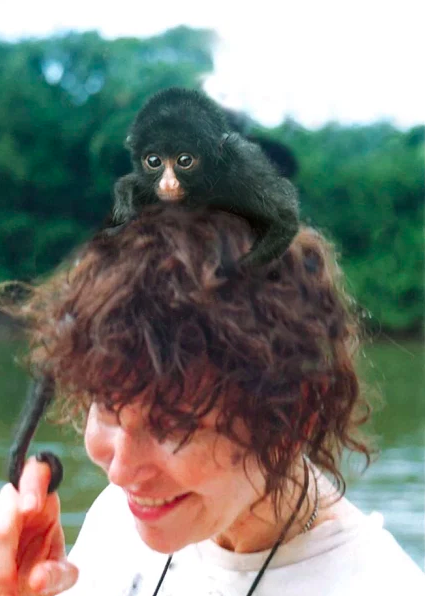
Barbara Crane Navarro is a French artist, author, and activist who currently lives near Paris. Over a period of 12 years, she spent the winter months with the Yanomami people in Venezuela and Brazil, an experience which has inspired her artistic practice and her decades-long effort to draw attention to the devastation of the Amazon Rainforest. From creating burning art installations to writing and illustrating a children’s book series, Crane Navarro is a prolific artist who has the power to instill a sense of urgency, responsibility, and connectedness in all those who interact with her creations.
We spoke with her about her biggest inspirations, what she is currently working on, and what makes the rainforest invaluable.
The following photos belong to Barbara Crane Navarro and have been republished with her permission.
How would you introduce yourself to someone sitting next to you (in a world where COVID-19 isn’t a threat, of course!) on a plane or train?
A conversation with a stranger usually starts with “Where are you from?” and I reply that I’ve lived in France for 43 years. I arrived in France in 1978 for a three-month visit with my two and a half-year old son and we’ve both lived here since.
Which places, people, things, or ideas inspire you to create art? Do you have a favorite medium? What do you hope to achieve with your art?
My inspiration and medium has evolved over time. I majored in painting at Rhode Island School of Design and the San Francisco Art Institute. My work transformed into multi-dimensional projects as I created the series of totemic sculptures influenced by the trance work of Yanomami shamans. My medium became fire as I publicly burned the totemic sculptures as performance art to protest against the continuing destruction of the world’s rainforests. My burning sculptures symbolize the degradation of nature and the annihilation of indigenous cultures that depend on the forests for their survival. My aspiration is to encourage people in the wealthy world to realize that our actions as consumers have repercussions on the lives of other people elsewhere.

Urihi (The forest) 
Mao (Water) 
Motoka (Sun) 
Aroki (Burnt by fire)
Navarro Crane created the paintings above on roughly woven canvas with a mixture of acrylics and plant-based pigments used by the Yanomami.
Can you share a bit about your experience with the Yanomami with our readers?
The impetus for my experiences with the Dogon in Mali, West Africa and the Yanomami in Venezuela and Brazil was my curiosity about different approaches to the idea of art and artists in other cultures. This questioning also brought new perspectives on ways of thinking and the sense of community. I saw how thoroughly our assumptions and attitudes are determined by the culture we live in.
From your perspective, what makes the Amazon Rainforest important and special?
From a personal point of view, I care deeply that Yanomami children have a future in an unpolluted and uncontaminated environment. The anxiety and fear generated in Yanomami communities by encroaching gold miners in their territory who propagate diseases, including COVID-19, is abhorrent. From a more global point of view, the climate crisis is exacerbated by the destruction of the world’s tropical forests and biodiversity. We need to become conscious of the fact that our own children’s future depends on protecting forests, too.
When I’m in the vast and magnificent forests or in a small boat on the rivers, I feel that I’m in the heart of life and I recognize how insignificant people are in that context.
What projects are you currently working on?
Light is the medium that I’m presently exploring in order to intensify my performance art pieces. The movement of the light in rhythm with the chants of the shamans is my objective.
What project are you most proud of?
My fantasy-adventure books for children on the Yanomami. They are factual and also fanciful tales of Yanomami life and bring up the issue of forest destruction in a way that children can relate to. I adored sharing the books with Yanomami children and how charmed they were with them.

If you could wave a magic wand and make any problem in the world disappear instantly, which would it be and why?
My magic wand would induce a change of perception so that humans would open their eyes to the evidence that we are just a part of nature and that all the living world is interdependent and we need to behave accordingly.
What are your favorite places in the Americas? Why?
The rainforests of the Amazon region. When I’m in the vast and magnificent forests or in a small boat on the rivers, I feel that I’m in the heart of life and I recognize how insignificant people are in that context.
Is there anything else you’d like to tell our readers?
Buy less, share more.
You can learn more about Barbara’s work by visiting her website or by checking out her Facebook and Twitter profiles. You can also purchase her children’s books online.


